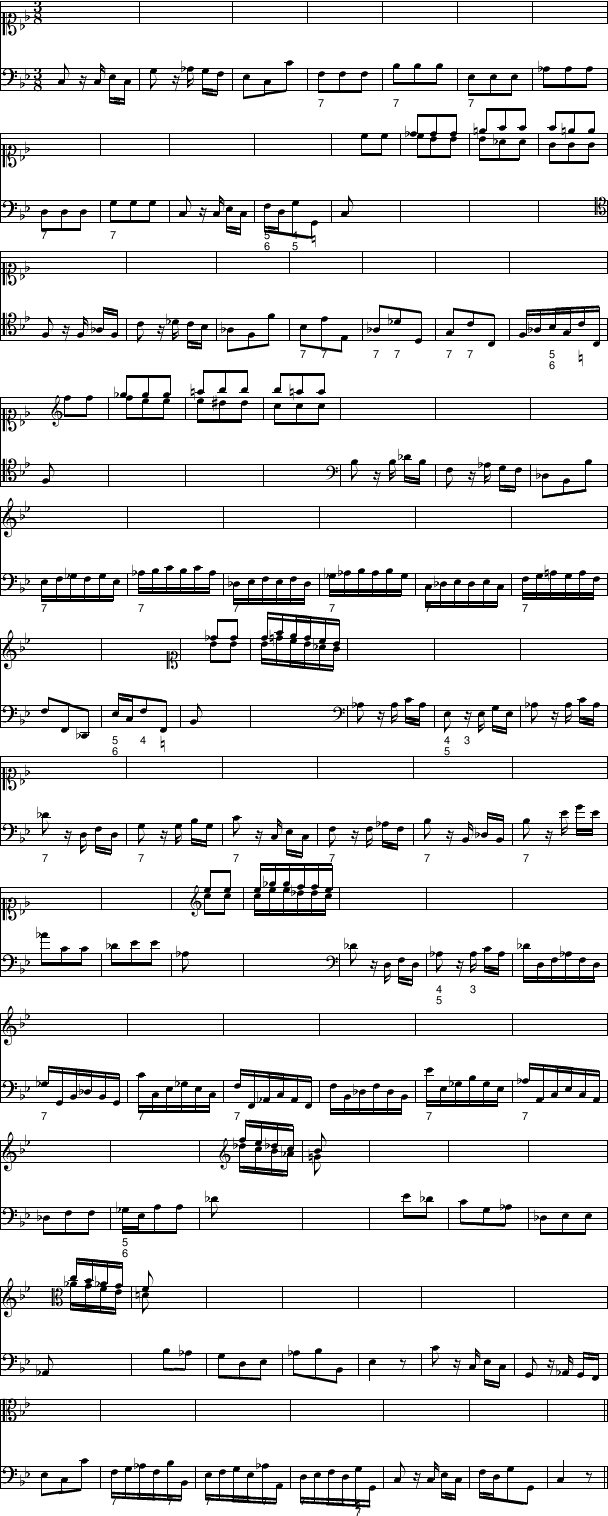|
Le consonanze della scala musica sono quattre. 3.a 5.a 6.a
8.va
|
The musical scale has four consonances. 3.a 5.a 6.a
8.va
|
Es gibt auf der musikalischen Leiter vier Konsonanzen. 3.a 5.a
6.a 8.va
|
Il y a quattre consonances dans l'échelle musicale. 3.a 5.a 6.a
8.va
|
|
La prima del tuono può ricevere 3.a 5.a 8.va
|
The first of the tonus may have 3.a 5.a 8.va
|
Die erste des Tones kann 3.a 5.a 8.va bekommen
|
La première du ton peux reçevoir 3.a 5.a 8.va
|
|
La seconda del tuono può ricevere 3.a minore 6.a maggiore 8.va
|
The second of the tonus may have minor 3.a major 6.a 8.va
|
Die zweite des Tones kann die kleine 3.a, die grosse 6.a und die
8.va bekommen
|
La deuxième du ton peux reçevoir 3.a mineure 6.a majeure 8.va
|
|
La terza del tuono può ricevere 3.a 6.a 8.va
|
The third of the tonus may have 3.a 6.a 8.va
|
Die dritte des Tones kann 3.a 6.a 8.va bekommen
|
La troisième du ton peux reçevoir 3.a 6.a 8.va
|
|
La quarta del tuono può ricevere 3.a 5.a 8.va quando va per
in contrare
|
The forth of the tonus may have 3.a 5.a 8.va when it goes
...
|
Die vierte des Tones kann 3.a 5.a 8.va bekommen, wenn sie
...
|
La quattrième du ton peux reçevoir 3.a 5.a 8.va quand elle va
...
|
|
La quinta del tuono può ricevere 3.a 5.a 6.a 8.va
|
The fifth of the tonus may have 3.a 5.a 6.a 8.va
|
Die fünfte des Tones kann 3.a 5.a 6.a 8.va bekommen
|
La cinquième du ton peux reçevoir 3.a 5.a 6.a 8.va
|
|
La quinta del tuono può ricevere 3.a maggiore 5.a 8.va
|
The fifth of the tonus may have major 3.a 5.a 8.va
|
Die fünfte des Tones kann die grosse 3.a, die 5.a und die 8.va
bekommen
|
La cinquième du ton peux reçevoir 3.a majeure 5.a 8.va
|
|
La sesta del tuono può ricevere 3.a 6.a 8.va
|
The sixth of the tonus may have 3.a 6.a 8.va
|
Die sexte des Tones kann 3.a 6.a 8.va bekommen
|
La sixième du ton peux reçevoir 3.a 6.a 8.va
|
|
La settima del tuono può ricevere 3.a 6.a 8.va
|
The seventh of the tonus may have 3.a 6.a 8.va
|
Die siebte des Tones kann 3.a 6.a 8.va bekommen
|
La septième du ton peux reçevoir 3.a 6.a 8.va
|
|
Il tuono può ricevere 3.a 6.a 5.a falsa, cioè maggiore
|
The tonus may have 3.a 6.a false , i.e. major
|
Der Ton kann 3.a 6.a und falsche, d.h. grosse bekommen
|
Le ton peux reçevoir 3.a 6.a fausse 5.a, c'est-à-dire majeure
|
|
La 5.a falsa e la 7.a minore possono essere amesse fra le
consonanze mentre sopra ongni semitoni, che muta sono, si può passare la
5.a falsa e sopra ogni 5.a del tono, che va al suo tono si può
passare la 7.a minore.
|
The false fifth and the minor seventh can be set inbetween the consonances,
to all half notes which are altered one can put the false fifth, on all
fifth of the tonus which go to its tonus one can pass by the minor seventh.
|
Die falsche Quinte und die kleine Septe können zwischen den Konsonanzen
angebracht werden, bei allen Halbtönen, die alteriert sind, kann man die
falsche Quinte berühren, und über allen Quinten des Tones die in ihren Ton
gehen kann man die kleine Septime berühren.
|
La fausse quinte e la septième mineure peuvent être mis parmi les consonances,
sur tout les demi tons qui sont alterés, la fausse quinte peut passer, et sur
tout les quintes du ton qui von vers son ton, la septième mineure peut passer.
|
|
Le seguenti Cadenze si potrano fare in tre posizioni alla mano Destra.
|
The following cadences can be played in the positions of the right hand.
|
Die folgenden Kadenzen können in drei Positionen der rechten Hand gemacht
werden.
|
Les cadences suivantes peuvent être fait en trois positions de la main droite.
|
|
Si come si vede in questo primo esempio.
|
As one can see in this first example.
|
Wie man in diesem ersten Beispiel sehen kann.
|
Comme on peut voir dans ce premier exemple.
|
|
prima positione
|
first position
|
erste Position
|
première position
|
|
seconda positione
|
second position
|
zweite position
|
deuxième position
|
|
|
terza positione
|
third position
|
dritte position
|
troisième position
|
|
|
Cadenze semplici per varij tonij
|
Simple cadences in various keys
|
Einfache Kadenzen in verschiedenen Tonarten
|
Cadences simples en tonalités différentes
|
|
|
Il diesis solo sopra o sotto la nota del Basso significa 3.a maggiore
|
The sharp lonely above or below the bass note indicates major 3.a
|
Das Kreuz alleine über oder unter der Bassnote zeigt eine grosse Terz an
|
Le dièse seul au dessus ou au desous la note de la basse signifie la tierce
majeure
| |
vicino al numero significa quel numero maggiore
|
next the figure indicates this figure [being] major
|
neben der Ziffer bezeichnet diese Ziffer [als] gross
|
voisiné du numéro signifie ce numero [doit être] majeure
| |
cosi ancore il B molle, e B quadro solo significa 3.a minore
|
and also the flat and the natural lonely indicate a minor third
|
und so auch das b oder das Auflösungszeichen alleine [das] die kleine Terz
anzeigt
|
ainsi que le bé mol et le b carré seule signifie la tierce mineure
| |
vicino al numero significa quel numero minore
|
next to the figure it indicates this figure [being] minor
|
neben der Ziffer bezeichnet diese Ziffer [als] klein
|
voisiné du numéro signifie ce numero [doit être] majeure
|
|
|
|
|
La 7.a minore e la 5.a falsa per lo piu devono calare alla
3.a
|
The minor seventh and the false fifth must in most cases go into the third
|
Die kleine Septime und die falsche Quinte müssen am häufigsten in die Terz
absteigen
|
La settième mineure et la fausse quinte doivent le plus souvent aller vers la
tierce
|
|
|
|
|
|
|
quando la prima del tono sta in 3.a minore, la quarta del tono per lo piu
riceverà 3.a minore.
|
When the first of the key stays in minor third, the fourth of the key get
most often the minor third.
|
Wenn die erste des Tones mit kleiner Terz steht, bekommt die vierte des Tones
um so mehr die kleine Terz.
|
Quand la première du ton est en tierce mineure, la quattrième du to reçoit
la plus souvent la tierce mineure.
|
|
|
|
|
|
|
|
|
|
|
|
|
|
|
|
|
La nota che siegue appresso la 5.a del tono calando di grado per lo piu
riceverà le medeme consonanze della 5.a del tono.
|
The note which follows upon the fifth of the key and descends stepwise gets
most often the same consonances as the fifth of the key.
|
Die Note, die auf die Quinte des Tones stufenweise absteigend folgt, bekommt
meistens dieselben Konsonanzen wie die Quinte des Tones.
|
La note qui suit après la quinte du ton descandant graduellement reçoit le plus
souvant le même consonances que la quinte du ton.
|
|
|
|
|
|
|
|
|
|
|
|
|
|
|
Salire per settima e il medemo che calare di grado.
|
Rising a seventh is the same as descending a note.
|
Eine Septe aufzusteigen ist dasselbe wie einen Ton abzusteigen.
|
Sauter par une settième vers le haut vient au même que descendre conjointement
par une note.
|
|
|
Le corde stabili, o pure ferma, che conservano il tono, sono tres.
|
There are three stable chords, or ..., which conserve the key.
|
Es gibt drei stabile oder ... Saiten, die den Ton erhalten.
|
Il y a trois cordes stables ou ... qui gardent le ton.
| |
la 7.a del tono maggiore, la quarta del tono minore, e la 2.a
del tono maggiore.
|
the seventh of the mayor key, the fourth of the minor key and the second of the
major key.
|
die Septime des grossen Tons, die Quarte des kleinen Tons und die Sekund des
grossen Tons.
|
la settième du to majeur, la quarte du ton mineur et la seconde du ton mineur.
| |
Cambiandosi una di queste in maggiore, o minore, si fà uscita di tono.
|
Changing one of those in major or minor, will leave the key.
|
Wenn eine dieser in gross oder klein geändert wird, verlässt man den Ton.
|
Changer une de celles-ci en majeure ou mineure va faire quitter le ton.
| |
ed ogni tono, nel quale si fà uscita, per? interde ?per primo di faro, e si
osserv... il medemo ordine finoa praticato
|
|
|
|
|
|
|
|
|
|
|
|
|
|
|
|
Di più si fà uscita di tono, cambiandosi la sesta, o terza del tono in
maggiore o minore
|
Changing the sixth or the third of the key in major or minor leaves most the
key.
|
Man verlässt am meisten den Ton, wenn man die Sexte oder die Terz des Tones in
gross oder klein verändert.
|
Le plus onn fait quitter le ton en changeant la sixte ou la tierce du ton
vers majeure ou mineure.
| |
in somma il semitono cambia sempre il tono
|
altogether, the half note always changes the key.
|
In Summa, dier Halbton verändert immer den Ton.
|
En somme, le demi ton change toujours le ton.
|
|
|
|
|
|
|
|
|
|
|
|
|
Uscite di tono, che si fanno immediatamente, senza prevenirle con accidenti
o di diesis, o di b molle, e si conoscerà il tono, nel quale si và, dalle sue
corde.
|
Leaving the key, which is done immediately, without forseeing with accidentals
either sharp or flat, and the key into which one is going one recognises by its
strings.
|
Verlassen des Tones, was unmittelbar geschieht, ohne Vorwarnung vermittels
Akzidenzien, entweder Kreuz oder b, und den Ton, in welchen man geht, erkennt
man an seinen Saiten.
|
Quitter le ton, ce qui se fait immediatement, sans prevenir avec des
altérations (?) soit dièse, soit bémol, et on reconnaît le ton dans lequel on
va, par ses cordes.
|
|
|
|
|
|
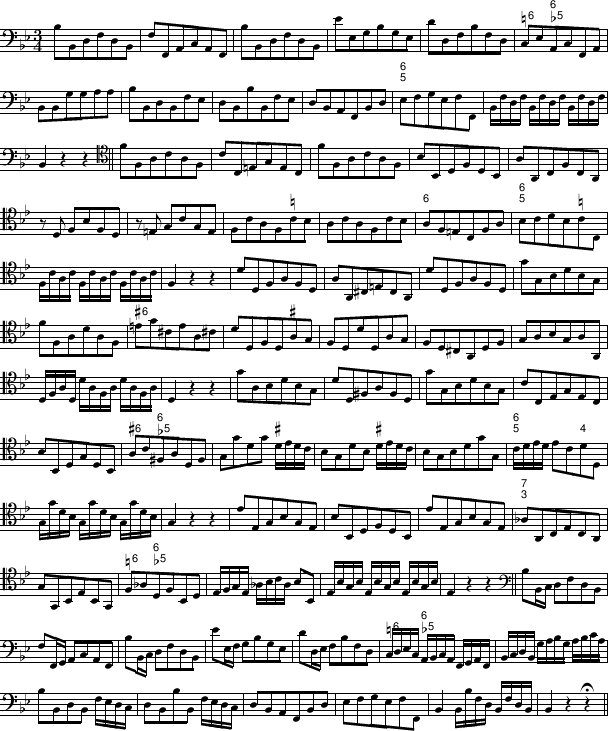
|
Spiega sopra le Dissonanze
|
Explanation of the dissonances
|
Erklärung der Dissonanzen
|
Explication des dissonances
| |
Le dissonanze della Musica sono quattro, 4.a 7.a e
2.a.
|
There are four dissonances in the music, the fourth, the seventh, the nineth
and the second.
|
Es gibt vier Dissonanzen in der Musik, die Quarte, die Septime, die None und
die Sekunde.
|
Il y en a quattre dissonances dans la musique, la quarte, la septième,
la neuvième et la seconde.
| |
Spiega sopra la 4.a
|
Explanation of the fourth.
|
Erklärung der Quarte.
|
Explication de la quarte.
| |
La 4.a e una delle dissonanze, la quarta deve essere preparata, e
risoluta.
|
The fourth is one of the dissonances, the fourth must be prepared and resolved.
|
Die Quarte ist eine der Dissonanzen, die Quarte muss vorbereitet und aufgelöst
werden.
|
La quarte est une des dissonaces, la quarte doit être preparé et resolué.
| |
Detta 4.a può essere preparata da fatter le Consonanze, cioè dalla
8.va 5.a 6.a 3.a.
|
The said fourth may be prepared by making the consonances, i.e. the octave, the
fifth, the sixth and the third.
|
Die besagte Quarte kann durch Konsonanzen vorbereitet werden, nämlich durch
die Oktave, die Quinte, die Sexte und die Terz.
|
La dit quarte peut être preparée en faisant les consonances, c'est-à-dire
l'octave, la quinte, la sixte et la tierce.
| |
Detta 4.a s'accompagna per lo piu colla 5.a o colla 6.a.
|
The said fourth is mostly accompanied by the fifth or by the sixth.
|
Die besagte Quarte wird meistens von der Quinte oder der Sexte begleitet.
|
La dit quarte s'accompagne plus souvent par la quinte out la sixte.
| |
Dalla 8.va può essere preparata la 4.a quando il Basso sale per
5.a o quando cala per 4.a.
|
The fourth may be prepared by the octave when the bass raises a fifth or
descends a fourth.
|
Die Quarte kann von der Oktave vorbereitet werden, wenn der Bass eine Quinte
auf- oder eine Quarte absteigt.
|
La quarte peut être preparé par l'octave quand la basse monte par une quinte
ou descend par une quarte.
| |
Esempio della 4.a preparata dall'8.va
|
Example of the fourth prepared by the octave.
|
Veispiel der von der Oktave vorbereiteten Quarte.
|
Exemple de la quarte preparée par l'octave.
|
|
|
Cadenze Composte per varj toni.
|
Cadences in various keys.
|
Kadenzen in verschiedenen Tonarten.
|
Cadences en différentes tonalités.
|
|
|
|
|
Dalla 5.a si prepara la 4.a quando il Bass sale per grado o
sbalzo per sotto
|
From the fifth the fourth is prepared when the bass ascends step by step
or jumps a seventh downwards.
|
Von der Quinte wird die Quarte vorbereitet, wenn der Bass stufenweise aufsteigt
oder eine Septe abspringt.
|
Par la quinte on prepare la quarte quand la basse ascends conjointement ou
saut par une septième vers le bas.
| |
Esempio della 4.a prevenuta dalla 5.a
|
Beispiel der von der Quinte vorbereiteten Quarte.
|
Example of the fourth prepared by the fifth.
|
Exemple de la quarte preparé par la quinte.
|
|
|
Cadenze composte per varj toni.
|
Composed cadences in various keys.
|
Zusammengesetzte Kadenzen in verschiedenen Tonarten.
|
Cadences composées en différentes tonalités.
|
|
|
|
|
Dalla 6.a si prepara a 4.a quando il Basso slae per 3.a o
quando fa sbalzo per 6.a sotto
|
|
|
| |
Esempio della 4.a preparataa dalla 6.a.
|
Example of the fourth prepared by the sixth.
|
Beispiel der von der Sexte vorbereiteten Quarte.
|
Exemple de la quarte preparé par la sixte.
|
|
|
|
|
Dalla 3.a si prepara la 4.a quando il Basso cala di grado.
|
By the third the fourth is prepared when the bass rises stepwise.
|
Durch die Terz wird die Quarte vorbereitet, wenn der Bass stufenweise steigt.
|
Par la tierce se prepare la quarte quand la basse ascende conjointement.
| |
Esempio della 4.a prevenuta dalla 3.a.
|
Example of the fourth prepared by the third.
|
Beispiel der Quarte, der die Terz vorangeht.
|
Exemple de la quarte avec la tierce avant.
|
|
|
|

|
Di piu detta 4.a può essere preparata dalla 5.a falsa, e dalla
7.a minore:
|
Most often the said fourth can be prepared by the false fifth, and by the minor
seventh.
|
Am häufgsten kann die besagte Quarte von der falschen Quinte und der kleinen
Septime vorbereitet werden.
|
Le plus souvent la dite quarte peut être preparé par la fausse quinte et par
la septième mineure.
| |
Dalla 5.a falsa può essere preparata, quando il Basso sale per semitono.
|
By the false fifth [it] may be prepared when the bass rises a half note.
|
Von der falschen Quinte kann [sie] vorbereitet werden, wenn der Bass einen
Halbton aufsteigt.
|
Par la fausse quinte [elle] peut être preparé quand la basse ascend par un
demiton.
| |
Dalla 7.a minore può essere preparata, quando il Basso dalla 5.a
del suo tono ritorna al suo tono.
|
By the minor seventh [it] may be prepared when the bass returns from the fifth
of the key to its [base] note.
|
Von der kleinen Septe kann [sie] vorbereitet werden, wenn der Bass von der
Quinte des Tones zu seinem [Grund-] Ton zurückkehrt.
|
Par la setpième mineure [elle] peut être preparé quand la basse retoure de
la quinte du ton vers son ton [fondamental].
| |
Esempio della 4.a prevanuta dalla 5.a falsa.
|
Example of the fourth prepared by the false fifth.
|
Beispiel der von der falschen Quinte vorbereiteten Quarte.
|
Exemple de la quarte preparé par la fausse quinte.
|
|
|
Esempio della 4.a preparata dalla 7.a minore.
|
Example of the fourth prepared by the minor seventh.
|
Beispiel der von der kleinen Spete vorbereiteten Quarte.
|
Exemple de la quarte preparé par la septième mineure.
|
|
|
|
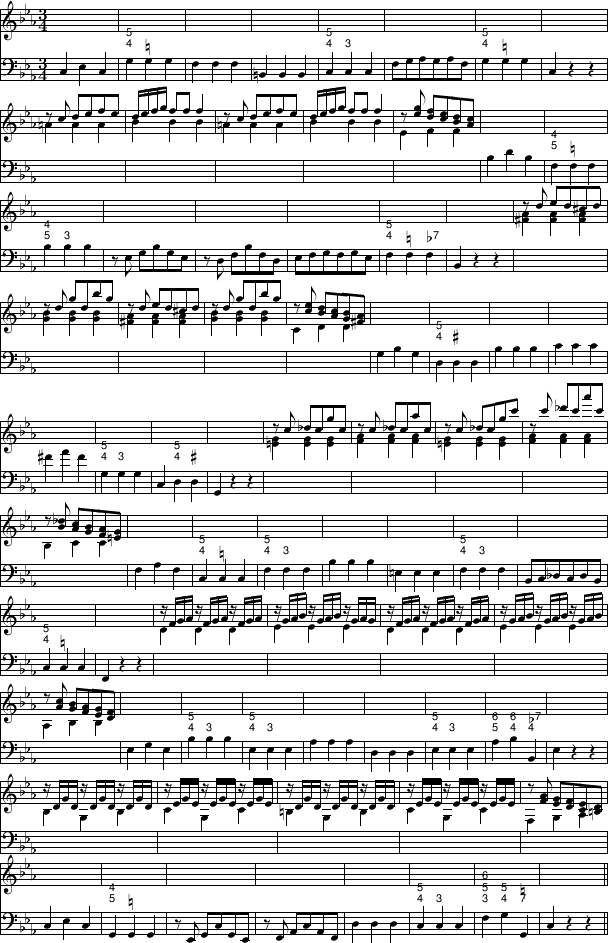
|
Spiega sopra la ligatura della 7.a.
|
Explanation of the suspension of the seventh.
|
Erläuterung des Septvorhaltes.
|
Explication du retard de la septième.
| |
La 7.a è una delle dissonanze, la quale deve esser prevenuta e risoluta.
|
The seventh is one of the dissonances which has to be prepared and to be
resolved.
|
Die Septime ist eine der Dissonanzen, welche vorbereitet und aufgelöst werden
muss.
|
La septième est une des dissonances, laquelle doit être preparé et resolue.
| |
Detta 7.a può essere prevenuta da ?atter le consonanze.
|
The said seventh may be prepared by playing the consonances
|
Die besagte Septime kann vorbereitet werden, indem man die Konsonanzen macht.
|
La dite septième peut être preparé en faisant les consonances.
| |
Della 8.va 6.a 5.a e 3.a.
|
By the octave, the sixth, the fifth and the third.
|
Durch die Oktave, die Sexte, die Quinte und die Terz.
|
Par l'octave, la sixte, la quinte et la tierce.
| |
L'accompagnamento della 7.a è la 3.a e la 5.a mà la piu
neccessario la 3.a.
|
The accompaniment of the seventh is the third and the fifth, but the most
necessary is the third.
|
Die Begleitung der Septime ist die Terz und die Quinte, am wichtigsten ist aber
die Terz.
|
L'accompagnement de la septième est la tierce et la quinte, mais la plus
neccesaire est la tierce.
| |
Dalla 8.va si prepara la 7.a quando il Basso sale per grado.
|
The seventh is prepared by the octave when the bass rises stepwise.
|
Die Septe wird von der Oktave vorbereitet, wenn der Bass stufenweise aufsteigt.
|
La septième est preparé par l'octave quand la basse ascend conjointement.
| |
Esempio della 7.a preparata dalla 8.va.
|
Example of the seventh prepared by the octave.
|
Beispiel der von der oktave vorbereiteten Septime.
|
Exemple de la septième preparé par l'octave.
|
|
|
|
|
Dalla 6.a si prepara la 7.a quando il Basse cala per grado.
|
By the sixth the seventh is prepared when the bass descends stepwise.
|
Von der Sexte wird die Septime vorbereitet, wenn der bass stufenweise absteigt.
|
Par la sixte la septième est preparé quand la basse descend conjointement.
| |
Esempio della 7.a prevenuta della 6.a
|
Example of the seventh prepared by the sixth.
|
Beispiel der von der Sexte vorbereiteten Septime.
|
Exemple de la septième preparé par la sixte.
|
|
|
|
|
Dalla 5.a si prepara la 7.a quando il Basso sala per sesta, o
quando cala per terza.
|
By the fifth the seventh is prepared when the bass rises by a sixth or descends
by a thrid.
|
Von der Quinte wird die Septime vorbereitet, wenn der Bass eine Sexte aufsteigt
oder eine Terz absteigt.
|
Par la quinte la septième est preparé quand la basse saut par une sixte vers
le haut ou par une tierce par le bas.
| |
Esempio della 7.a prevenuta dalla 5.a.
|
Example of the seventh preceeded by the fifth.
|
Beispiel der Septime, der die Quinte vorangeht.
|
Exemple de la septième avec la quinte précédent.
|
|
|
|
|
Dalla 3.a si prepara la 7.a quando il Basso sale per quarta o
scender per 5.a.
|
By the third the seventh is prepared when the bass raises a fourth or descends
a fifth.
|
Von der Terz wird die Septime vorbereitet, wenn der Bass ein Quart auf- oder
eine Quinte absteigt.
|
Par la tierce la septième est preparé quand la basse monte par une quarte ou
descend par une quinte.
| |
Esempio della 7.a prevenuta dalla 3.a.
|
Example ov the seventh preceded by the third.
|
Beispiel der Septime, der die Terz vorangeht.
|
Exemple de la septième precédée par la tierce.
|
|
|
|

|
Spiega Sopra la ligatura della .
|
Explanation of the suspension of the nineth.
|
Erläuterung des Nonvorhalts.
|
Explication du redard de la neuvième.
| |
La è una delle dissonanze, la quale dever essere preparata, e risoluta.
|
The nineth is one of the dissonances which must be prepared and resolved.
|
Die None ist einer der Dissonanzen, welche vorbereitet und aufgelöst werden
muss.
|
La neuvième est une des dissonances, laquelle doit être preparé et resolue.
| |
Detta può essere preparata dalla 3.a e dalla 5.a.
|
The said nineth may be prepared by the third and by the fifth.
|
Besagte None kann von der Terz und der Quinte vorbereitet werden.
|
La dite neuvième peut être preparé par la tierce et par la quinte.
| |
L'accompagnamento della è la X.a cioè la 3.a e la 5.a
ma il piu necessari è la X.a.
|
The accompaniment of the nineth is the tenth, that is the third and the fifth,
but the most necessary is the tenth.
|
Die Begleitung der None ist die Dezime, das ist die Terz und die Quinte, am
wichtigsten ist aber die Dezime.
|
L'accompagnement de la neuvième est la dixième, c'est-à-dire la tierce et la
quinte, mais le plus necessaire est la dixième.
| |
Dalla 3.a si prepara la quando il Basso sale per grado.
|
By the third the nineth is prepared when the bass rises in a step.
|
Von der Terz wird die None vorbereitet, wenn der Bass stufenweise aufsteigt.
|
Par la tierce la neuvième est preparé quand la basse monte conjointement.
| |
Esempio della prevenuta della 3.a.
|
Example of the nineth preceeded by the third.
|
Beispiel der None der die Terz vorausgeht.
|
Exemple de la neuvième avec la tierce precedent.
|
|
|
|
|
Dalla 5.a si prepara la , quando il partimento sale per quarta, o
quando cala per quinta.
|
By the fifth the nineth is pepared when the partimento rises a fourth or
descends a fifth.
|
Von der Quinte wird die None vorbereitet, wenn der Partimento eine Quarte auf-
oder eine Quinte absteigt.
|
Par la quinte la neuvième est preparé quand le partimento monte une quarte ou
descend une quinte.
| |
Esempio della preparata dalla 5.a.
|
Example of the nineth prepared by the fifth.
|
Beispiel der von der Quinte vorbereiteten None.
|
Exemple de la neuvième preparé par la quinte.
|
|
|
|

|
Spiega sopra la ligatura della 7.a e insieme.
|
Explanation of the redard of the seventh and nineth together.
|
Erläuterung des gleichzeitigen Sept- und Nonvorhaltes.
|
Explication de retard de la septième et la neuvième ensemble.
| |
Ligatura di 7.a e si può fare, quando il Basso sale per grado,
ove la 7.a sarà preparata dalla 8.va e la dalla 3.a.
|
A suspension of the seventh and the nineth one can make when the bass rises
a step or where the seventh will be prepared by the octave and the nineth by
the third.
|
Einen Sept-Non-Vorhalt kann man machen, wenn der Bass stufenweise aufsteigt,
wenn die Septime von der Oktave vorbereitet wird und die None von der
Terz.
|
Le retard de la sptième et la neuvième on peut faire quand la basse monte
conjointement, où la septième sera preparé par l'octave et la neuvième par la
tierce.
| |
e volendole dare accompagnamento, se le può dara la 3.a
|
and if one wants to give an accompaniment, one may give the third.
|
und wenn man eine Begleitung geben will, kann man die Terz geben.
|
et si on veut donner un accompagnement, on peut donner la tierce.
| |
Esempio della 7.a e quando il Basso sale per grado senza
accompagnamento della 3.a
|
Example of the seventh and the nineth when the bass rises stepwise, without
accompaniment of the third.
|
Beispiel der Septe und der None, wenn der Bass stufenweise aufsteigt, ohne
Begleitung der Terz.
|
Exemple de la septième et la neuvième quand la basse monte conjointement, sans
accompagnement de la tierce.
|
|
|
Altro Esempio della 7.a e coll'accompagnamento della 3.a
|
Another example of the seventh and the nineth with accompaniment of the third.
|
Anderes Beispiel der Septe und der None mit Begleitung der Terz.
|
Autre exemple de la septième et la neuvième avec accompagnement de la tierce.
|
|

|
La medema ligatura di 7.a e si può fare, quando il Basso cala
per 5.a o sale per 4.a, ove la 7.a sarà prevenuta dalla
3.a e la dalla 5.a
|
One can make the same suspension fo the seventh and the nineth when the bass
descends a fifth or rises a fourth, where the seventh will be prepared by the
third and the nineth by the fifth.
|
Denselben Vorhalt der Septe und der None kann man machen wenn der Bass eine
Quarte auf- oder eine Quinte absteigt, wodurch die Septime durch die Terz
vorbereitet wird und die None drch die Quinte.
|
Le même retard de la septième et la neuvième on peut faire quand la basse
descend par une quinte ou monte par une quarte, où la septième sera preparé
par la tierce et la neuvième par la quinte.
| |
e volendo dara accompagnamento, si potrà dara la 3.a.
|
and if one wants to give an accompaniment, on can give the third.
|
und wenn man eine Begleitung geben will, kann man die Tetz geben.
|
et si on veut donner un accompagnement, on peut donner la tierce.
| |
Esempio della 7.a e quando il Basso sale per 5.a
coll'accompagnamento della 3.a
|
Example of the seventh and the nineth when the bass descends a fifth, with
accompaniment of the third.
|
Beispiel der Septe und der None, wenn der Bass eine Quinte absteigt, mit
Beleitung der Terz.
|
Exemple de la septième et la neuvième quand la basse descend un quinte, avec
accompagnement de la tierce.
|
|
|
Altro Esempio della 7.a e quando il Basso sale per 5.a
senza accompagnamento della 3.a.
|
Another example of the seventh and the nineth when the bass descends a fifth,
without accompaniment of the third.
|
Anderes Beispiel der Septe und der None, wenn der Bass eine Quinte absteigt,
ohne Beleitung der Terz.
|
Autre exemple de la septième et la neuvième quand la basse descend un quinte,
sans accompagnement de la tierce.
|
|
|
|
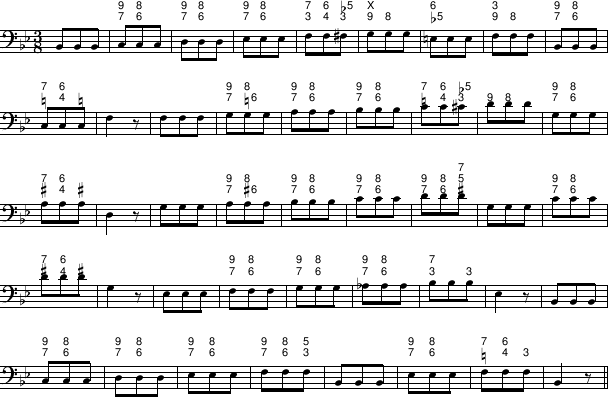
|
Spiega sopra la ligatura della 4.a e la insieme.
|
Explanation of the suspension of the fourt and th nineth together.
|
Erläuterung des Quart-Non-Vorhaltes.
|
Explication du retard de la quarte et la neuvième ensemble.
| |
Ligatura di 4.a a si può fare, quando il Basso sale per semitono
ove la 4.a sarà prevenuta dalla 5.a falsa, e la dalla
3.a
|
The suspension of the fourth and the nineth one can make when the bass rises
a half note, where the fourth will be preceeded by the false fifth and the
nineth by the third.
|
Den Quart-Non-Vorhalt kann man machen, wenn der Bass einen Halbton steigt,
wobei der Quarte die falsche Quinte vorausgeht und der None die Terz.
|
Le retard de la quarte et la neuvième peut être fait quand la basse monte un
demi ton, où la quarte sera preparé par la fausse quinte et la neuvieme par
la tierce.
| |
volendo dare accompagnamento, si potrà dare la 5.a.
|
when one wants to give an accompaniment, one can give the fifth.
|
wenn man eine Begleitung geben will, kann man die Quinte geben.
|
si on veut donner un accomgnement, on peut donner la quinte.
| |
Esempio della 4.a e quando il Basso sale per semitono senza
accompagnamento della 5.a.
|
Example of the fourth and the nineth when the bass rises a half note, without
accompaniment of the fifth.
|
Beispiel der Quarte und der None, wenn der Bass einen Halbton steigt, ohne
Begleitung der Quinte.
|
Exemple de la quarte et la neuvième quand la basse monte un demi ton, sans
accompagnement de la quinte.
|
|
|
Altro Esempio coll'accompagnamento della 5.a.
|
Other example with accompaniment by the .
|
Anderes Beispiel mit Begleitung durch die Quinte.
|
Autre exemple avec accompagnement par la quinte.
|
|
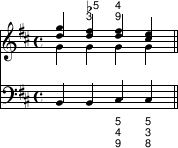
|
La medema ligatura della 4.a et su può fare, quando il Basso va
dalla 5.a del tono al suo tono, ove la 4.a sarà preparata dalla
7.a minore e la dalla 5.a.
|
The same suspension of the fourth and the nineth one can make when the bass
goes from the fifth of the key to its [base] note, where the fourth will be
prepared by the minor seventh and the nineth by the fifth.
|
Denselben Vorhalt der Quarte und None kann man machen, wenn der Bass von der
Quinte des Tones auf den [Grund-] Ton geht, sodass die Quarte von der kleinen
Septime vorbereitet wird und die None von der Quinte.
|
Le même retard de la quarte et la neuvième on peut faire quand la basse va de
la quinte du ton sur le ton, où la quarte sera preparé par la septième
mineure et la neuvième par la quinte.
| |
Esempio della 4.a e quando il Basso và dalla 5.a del tono
al tono, senza accompagnamento della 5.a.
|
Example of the fourth and the nineth when the Bass goes from the fifth of the
key to the [base] note, without accompagnement if the fifth.
|
Beispiel der Quarte und der None wenn der Bass von der Quinte des Tones auf den
[Grund-] Ton geht, ohne Begleitung der Quinte.
|
Exemple de la quarte et la neuvième quand la basse va de la quinte du ton vers
le ton, sens accompagnement de la quinte.
|
|
|
Altro Esempio coll'accompagnamento della 5.a.
|
Another example with accompaniment by the fifth.
|
Anderes Beispiel mit Begleitung der Quinte.
|
Autre exemple avec accompagnement par la quinte.
|
|
|
|
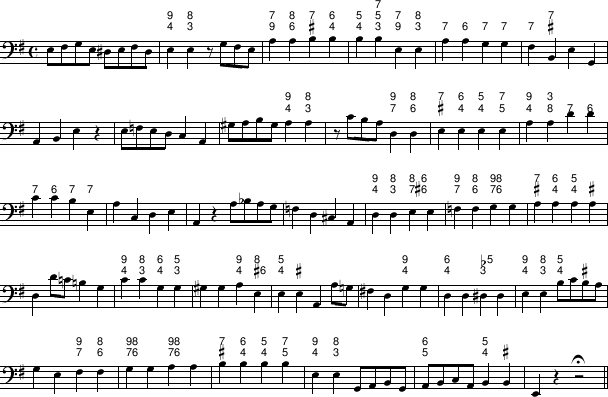
|
Spiega sopra la 2.a.
|
Explanation of the second.
|
Erläuterung der Sekunde.
|
Explication de la seconde.
| |
La 2.a è una delle dissonanze, la quale non deve essere prevenuda
dalle consonanze, ma la previene il Basso, cioè adire quando il Basso lega
si da detta si come si vedere nella spiega del Basso legato.
|
The second is one of the consonances which must not be preceeded by
consonances, but is prepared by the bass, i.e. it occurs when the bass suspends
the said second, as to be seen in the explanation of the tied bass.
|
Die Sekunde ist eine der Dissoanzen, welcher keine Konsonanzen vorangehen
dürfen, sondern die vom Bass vorbereitet wird, das heisst, wenn der Bass die
besagte Sekunde bindet, wie in der Erläuterung des gebundenen Basses zu sehen.
|
La seconde est une des dissonances qui ne doit pas être preparé par des
consonances, mais la basse la prepare, c'est-à-dire quand la bass lie la
dite seconde, comme on voit dans l'explication de la bassee liée.
| |
Spiega sopra il Basso legato.
|
Explanation of the tied bass.
|
Erläuterung des gebundenen Basses.
|
Explication de la bassee liée.
| |
Quando il Basso fà legatura e conserva il tono, la nota ligata riceverà per
suo accompagnamento 4.a minore e 6.a, le piu necessarie
sono e 4.a.
|
When the bass is tied and holds the note, the tied note gets as its
accompaniment the second, the minor fourth and the sixth, the most necessary
are second and fourth.
|
Wenn der Bass gebunden ist und den Ton hält, erhält die gebundene Note als
Begleitung die Sekunde, die kleine Quarte und die Sexte, am wichtigsten sind
Sekunde und Quarte.
|
Quand la basse fait une liaison et conserve la note, la note liée reçevoit
comme son accompagnement la seconde, la quarte mineure et la sixte, le plus
necessaire sont seconde et quarte.
| |
e sopra la note, che siegue appresso la nota ligata, calando di grado, detta
2.a rimaresà per 3.a e la 4.a per 5.a falsa.
|
and on the note which follows upon the tied note, descending stepwise, the
said second remains as third and the fourth as false fifth.
|
und über der Note, die auf die gebundene Note folgt, bleibt stufenweise
absteigend die besagte Sekunde als Terz liegen und die Quarte als falsche
Quinte.
|
| |
Esempio del Basso ligato che conserva il tono.
|
Example of the tied bass which keeps the note.
|
Beispiel des Basses, der die Note hält.
|
Exemple da la basse qui conserve la note.
|
|
|
Si può intendere Basso ligato ogni qual volta si ribatto la medesima nota
nel terzo, o primo quarto della battuta, senza che vi sia il segno della
ligatura, come si vede nej seguenti esempj.
|
One can always assume a tied bass when the same note is ristroke on the third
or firsth fourth of the bar, without that a tie is indicated, as to be seen
in the following examples.
|
Der Bass kann als gebunden angesehen, wenn immer dieselbe Note auf dem dritten
oder ersten Viertel des Taktes wieder angeschlagen wird, ohne dass eine Ligatur
angezeigt wird, wie man in den folgenden Beispielen sehen kann.
|
On peut entendre une basse liée toutes les fois quand la même note est répété
sour le premier ou troisieme quart de la mesure, sans être indiquation d'une
liaison, comme on peut voir dans les exemples souvants.
|
|
|
|
|
|
|
Altri Esempii, che significano Basso ligato.
|
Other examples which show a tied bass.
|
Andere Beispiele, die einen gebunden Bass demonstrieren.
|
Autres exemples qui signifient une basse liée.
|
|
|
La pausa può fare figura di nota ligata.
|
At a rest one may put the figure of the tied note.
|
Auf der Pause kann das Zeichen für die gebundene Note stehen.
|
La pause peut avoir le chiffre de la note liée.
| |
Esempio
|
Example
|
Beispiel
|
Esempio
|
|
|
Al punto ancora può fare figura di nota ligata.
|
Also at the point one may make the figure of the tied note.
|
Auch auf den Punkt kann man die Bezifferung der gebundenen Note machen.
|
Aussi au point on peut fair le chiffre de la note liée.
| |
Esempio
|
Example
|
Beispiel
|
Exemple
|
|
|
|
|
Di piu il Basso ligato, che conserva il tono può recevere per suo
accompagnamento 4.a e 5.a
|
Moreover, the tied bass who keeps the note may receive as its accompaniment the
?duodecim?, the fourth and the fifth.
|
Überdies kann der gebundene Bass, der den Ton hält, als seine Begleitung
die Duodezime und die Quarte erhalten.
|
De plus, la basse lieé qui conserve le ton peut reçevoir la ?duodecime?, la
quarte et la quinte comme son accompagnement.
| |
Esempio
|
Example
|
Beispiel
|
Exemple
|
|
|
Spiega sopra il Basso ligato, che non torna al tono.
|
Explanation of the tied bass which does not turn into the base note.
|
Erläuterung zum gebundenen Bass, der nicht in den Ton kehrt.
|
Explication sur la basse liée qui ne tourne pas au ton.
| |
La nota ligata, che non torna al tono per lo piu riceverà per suo
accompagnamento 2.a 4.a maggiore e 6.a.
|
The tied note which does not turn into the key/base note most often gets as
its accompaniment the second, the major fourth and the sixth.
|
Die gebundene Note, die nicht zum Ton zurückkehrt, erhält meistens die Sekunde,
die grosse Quarte und die Sexte als ihre Begleitung.
|
La note liée qui ne tourne pas au ton, reçevra le plus souvent la seconde, la
quarte majeure et la sixte comme son accompagnement.
| |
Se uscità nella quinta del tono, riguardo a quel tono ove in cominciò la nota
ligata, uscendo in altro tono, la nota ligata potrebbe ricevere in luogo
della 4.a maggiore, 4.a minore.
|
|
|
| |
Esempio
|
Example
|
Beispiel
|
Exemple
|
|
|
|
|
|
|
|
Di piu il Basso ligato, che non torna al tono, può ricevere 4.a 3.a
3.a o 6.a o 6.a
|
Furthermore, the tied bass which does not turn into the note may get the
4.a the 3.a the 3.a or the sixth. or the sixth.
|
Darüber hinaus kann der gebundene Bass, der nicht zum Ton zurückkehrt
4.a , 3.a , 3.a oder Sexte erhalten. oder Sexte erhalten.
|
De plus, la basse liée qui ne tourne pas au ton, peut reçevoir
4.a , 3.a , 3.a ou sixte. ou sixte.
|
il medemo accompagnamento di 3.a 4.a 4.a e 6.a
qualche volta può ricevere quella nota, che siegue appresso la prima, o
5.a del tono calando di grado. e 6.a
qualche volta può ricevere quella nota, che siegue appresso la prima, o
5.a del tono calando di grado.
|
The same accompaniment of 3.a , 4.a , 4.a and sixth may
sometimes be given to the note which follown upon the first or the fifth
of the key, descending a step. and sixth may
sometimes be given to the note which follown upon the first or the fifth
of the key, descending a step.
|
Dieselbe Begleitung der 3.a , 4.a , 4.a und Sexte kann
manchmal auch zu der Note gegeben werden, die auf die erste folgt oder die
fünfte des Tons, eine Stufe absteigend. und Sexte kann
manchmal auch zu der Note gegeben werden, die auf die erste folgt oder die
fünfte des Tons, eine Stufe absteigend.
|
la même accompagnement de 3.a , 4.a , 4.a et sixte peut
parfois recevoir la note qui suit après la première, ou la cinquième du ton,
en descendant conjointement. et sixte peut
parfois recevoir la note qui suit après la première, ou la cinquième du ton,
en descendant conjointement.
|
|
|
Di piu il Basso ligato può ricevere maggiore 4.a e 6.a,
ma le piu necessarie sono a 4.a.
|
Furthermore, the tied bass may get the major second, the fourth and the sixth,
but the most necessary are the second and the fourth.
|
Darüber hinaus kann der gebundene Bass die grosse Sekunde, die Quarte und die
Sexte erhalten, die nötigsten sind aber Sekunde und Quarte.
|
Et puis, la basse peut recevoir la seconde majeure, la quarte et la sixte,
mais les plus neccessaires sont seconde et quarta.
|
|

Di piu il Basso ligato può ricevere minore 4.a e 6.a,
ma le piu necessario sono  e 4.a. e 4.a.
|
Moreover, the tied bass may get the minor second, the fourth and the sixth,
but the most necessary are  and thr fourth. and thr fourth.
|
Des weiteren kann der gebundene Bass die kleine Sekunde, die Quarte und die
Sexte bekommen, die wichtigsten sind aber  und Quarte. und Quarte.
|
D'ailleurs, la basse liée peut recevoir la seconde mineure, la quarte et la
sixte, mais les plus necessaires sont  et quarte. et quarte.
|
Detta può restare sopra la nota seguente che cala di grado per
3.a o pure può immediate andare ad una 5.a sicome
occorrenzà. sicome
occorrenzà.
|
The said second may rest as a third upon the following note which descends a
step, or may immediately go to a 5.a , as needed. , as needed.
|
Die besagte Sekund kann als Terz über der folgenden Note liegen bleiben, die
eine Stufe absteigt, oder sofort in eine 5.a gehe, entsprechend
der Gelegenheit gehe, entsprechend
der Gelegenheit
|
La dite seconde peut rester comme tierce sur la note suivante qui descend
conjointement ou peut imediatement aller vers une 5.a selon
les circonstances. selon
les circonstances.
|
|

|
Spiega sopra alcuni moti piu necessari del Basso.
|
Explanations of some most neccessary motions of the Bass.
|
Erläuterung einiger häufig auftretender Bassbewegungen.
|
Explication de quelques mouvments plus necessaire de la basse.
| |
Quando il Basso descende di 5.a ed ascende di 4.a per piu note
s'accompagnata detto moto si dise ?endenter? ascendendo colla ligatura della
7.a.
|
When the bass descends a fifth and rises a fourth several times, then this
movement is accompanied ... by suspensions of the seventh.
|
Wenn der Bass mehrmals hintereinander eine Quinte ab- und eine Quarte
aufsteigt, dann begleitet man diese Bewegung ... mit Septvorhalten.
|
Quand la basse descende par une quinte et monte par une quarte par plusieur
notes, ce mouvement s'accompagne par ... retard de la quarte.
| |
e queste ligature della 7.a risolveranno alla 3.a.
|
and these suspensions of the seventh will be resolved by the third.
|
und diese Septvorhalte werden durch die Terz aufgelöst.
|
et ces retards de la septième seront resolus par la tierce.
| |
Esempio
|
Example
|
Beispiel
|
Exemple
|
|
|
|
|
|
|
Spiega sopra il moto, che per piu note cala di 3.a e ?
|
Explanation of the movement, in which several notes descend in thirds and ?
|
Erläuterung zur Bewegung, in dem mehrere Noten in Terzen absteigen und ?
|
Explication du mouvement ou plusieurs notes descendent en tierces et ?
| |
in detto moto la nota, che calerà per terza riceverà 5.a 6.a e
3.a, e la nota che salirà per grado riceverà 3.a ò pure
3.a e ?
|
In the said movement the note which descends a third gets the fifth, the sixth
and the third, and the note which rises stepwise gets the third or the nineth,
the third and ?
|
In der besagten Bewegung bekommt die Note, die eine Terz absteigt, die Quinte,
die Sexte und die Terz, und die Note, die stufenweise aufsteigt, bekommt die
Terz oder auch die None, die Terz und ?
|
Dans le dit mouvement la note qui descend une tierce recevra la quinte, la
sixte et la tierce, et la note qui monte conjointement recevra la tierce ou
bien la neuvième, la tierce et ?
| |
Esempio
|
Example
|
Beispiel
|
Exemple
|
|
|
Altro Esempio
|
Other example
|
Anderes Beispiel
|
Autre exemple
|
|
|
Altro Esempio con dare all nota che sale per grado.
|
Other exemple, giving the nineth to the note which rises a step.
|
Anderes Beispiel, wo der Note, die stufenweise steigt, die None gegeben wird.
|
Autre exemple avec la neuvième à la note qui monte conjointement.
|
|
|
|

|
Spiega sopra il moto, che per piu nota ascende per 5.a e discende per
4.a.
|
Explanation of the movement, which rises in fifths and descends in fourths over
several notes.
|
Erläuterung der Bewegung, die übere mehrere Noten in Quinte auf- und in Quarten
absteigt.
|
Explication du mouvement qui monte en quintes et descend en quartes par
plusieures notes.
| |
in detto moto, la nota che sale per 5.a e la nota che discende di
4.a riceveranno per accompagnamento 3.a e 5.a.
|
in the said movement, the note which rises a fifth and the note which
descends a fourth will get the third and the fifth as accompaniment.
|
In besagter Bewegung bekommt die Note, welche eine Quinte aufsteigt, und die
die Note, welche eine Quarte absteigt, die Terz und die Quinte.
|
| |
le 3.e saranno ad arbitrio, l'ultima dovrà essere maggiore.
|
The thirds will be ad will, the last one has to be major.
|
Die Terzen sind nach Belieben, die letzte muss gross sein.
|
Le tierces sont arbitraires, la dernière doit être majeure.
| |
Esempio
|
Exampple
|
Beispiel
|
Exemple
|
|
|
di piu in detto moto le note potranno ricevere per loro accompagnamento
ligatura di risoluta a 3.a.
|
Furthermore, in this movement the notes may get as their accompaniment a
suspenion of the fourth, resolved by the third.
|
Darüber hinaus können die Noten in dieser Bewegung als ihre Begleitung einen
Quartvorhalt erhalten, der durch die Terz aufgelöst wird.
|
D'ailleurs, les notes dans ce mouvement peuvent recevoir des retards de la
quarte resulues par la tierce comme leur accompagnement.
| |
Esempio
|
Exemple
|
Beispiel
|
Exemple
|
|
|
di piu in detta moto ogni nota nel fine potrà ricevere una 4.a maggiore.
|
Moreover, in this movement all last notes may get a major fourth.
|
Darüber hinaus können alle letzten Noten in dieser Bewegung eine grosse
Quarte erhalten.
|
De plus, dans ce mouvement tout les dernières notes peuvent recevoir une quarte
majeure.
| |
Esempio
|
Example
|
Beispiel
|
Exemple
|
|
|
Spiega sopra il moto che per piu note cala per quarta e sale per grado.
|
Explanation of the motion which descends in fourths and rises in seconds over
several notes.
|
Erläuterung der Bewegung, die in über mehrere Noten in Quarten ab- und
stufenweise aufsteigt.
|
Explication du mouvement où on descend par des quartes et on monte
conjointement pendand plusieurs notes.
| |
in detto moto la nota, che discende per quarta e la nota che sala per grado
receverà per suo accompagnamento 3.a e 5.a.
|
In the said movement the note which descands a fourth and the note which rises
a step get the third and the fifth as their accompagnement.
|
In besagter Bewegung bekommen die Note, die eine Quarte absteigt, und die Note,
die eine Stufe aufsteigt, die Terz und die Quinte als ihre Begleitung.
|
Dans le dit mouvement la note qui descende une quarte et la note qui monte
conjointement recevront la tierce et la quinte comme leur accomagnement.
| |
Esempio
|
Example
|
Beispiel
|
Exemple
|
|
|
di piu in detto moto, la nota che descende per quarte potra ricever 4.a
accompagnate colla 5.a e risoluta a 3.a, e la nota che sale per
grado potra ricevere risoluta all'8.va.
|
Moreover, in this movement the note which descands a fourth may get the fourth
accompanied by the fifth and resolved by the third, and the note which rises
a step may get the nineth resolved by the octave.
|
Darüber hinaus kann in dieser Bewegung die Note, die eine Quarte absteigt,
die Quarte erhalten, begleitet von der Quinte und aufgelöst durch die Terz, und
die Note, welche stufenweise aufsteigt, kann die in die Oktave aufgelöste
Note erhalten.
|
De plus, dans ce mouvement la note qui descende par une quarte peut recevoir la
quarte, accompagné par la quinte et resolue par la tierce, et la note qui monte
conjointement peut recevoir la neuvieme resolue par l'octave.
| |
Esempio
|
Example
|
Beispiel
|
Exemple
|
|
|
Il medemo moto diminuito.
|
The same movement diminuished
|
Dieselbe Bewegung diminuiert
|
Le même mouvement diminue
|
|
|
Spiega sopra il moto di quarta.
|
Explanation of th movement of the fourth.
|
Erläuterung der Quart-Bewegung.
|
Explication du mouvement de la quarte.
| |
Il moto di quarta che non cambia tono potrà ricevere li seguenti
accompagnamenti.
|
The movement of the fourth which does not change the key may get the following
accompaniments.
|
Die Bewegung der Quarte, die nicht den Ton verlässt, kann folgende Begleitungen
erhalten.
|
Le mouvement de la quarte qui ne change la tonalité (ton?), peut recevoir les
accompagnements suivants.
| |
Esempio
|
Example
|
Beispiel
|
Exemple
|
|
|
|
|
Il moto de 4.a che cambia tono, potrà ricevere li seguenti
accompagnamenti.
|
the movement of the fourth which changes the key [note?] may get the
following accompaniments.
|
Die Quart-Bewegung, welche den Ton ändert, kann folgende Begleitungen bekommen.
|
Le mouvement de la quarte qui change le ton [la tonalité?] peut recevoir
les accompagnements suivants.
| |
Esempio
|
Example
|
Beispiel
|
Exemple
|
|
|
|
|
|
|
|
|
|
|
Spiega sopra il moto o...? o pure moto, che sembro che ?espenda un poco da
cadenza ? camino
|
|
|
|
|
|
Il seguente moto per lo piu sarà accompagnata, s? , apparisce al seguente
esempio.
|
|
|
|
|
|
La sesta del tono, quando il Basso farà il seguente moto, potra ricevere per
suo accompagnamento 5.a.
|
The sixth of the key may get the fifth as its accompaniment when the bass does
the following movement.
|
Die Sexte des Tones kann die Quinte als ihre Begleitung erhelten, wenn der Bass
folgende Bewegung macht.
|
La sixte du ton peut recevoir la quinte comme son accompagnement quand la basse
fait le mouvement suivant.
|
|
|
Detta sesta del tono receverà li seguenti accompagnamenti.
|
The said sixth of the key gets the following accompaniments.
|
Die besagte Sexte des Tones bekommt folgende Begleitungen.
|
La dite sixte du ton recevra les accompagnements suivants.
|
|
|
quando la cantilena stà in 3.a minore, detta sesta del tono potrà recever
il seguente accompagnamento.
|
When the cantilene is minor third, the said sixth of the key may get the
following accompaniment.
|
Wenn die Kantilene in der kleinen Terz steht, kann besagte Sexte die folgende
Begleitung erhalten.
|
Quand la cantilène est en tierce mineure, la dite sixte peut recevoir
l'accompagnement suivant.
|
|
|
la nota ferma, o di? battuta, altrimento detto pedale può ricevere viarij
accompagnamentj, accennerò pochj, che ? essere ?
|
|
|
|
|
|
|
|
|
|
|
|
Si devono evitare, quando sia possibiter, due 8.ve o due 5.e una
immediate appresso l'altra: colla mano superiore riguardo al Basso,
|
On has to avoid as much as possible two octaves or two fifth one immediately
after the other: with the upper hand with respect to the bass,
|
Man muss, soweit es möglich ist, zwei unmittelbar aufeinander folgende
Oktaven oder Quinten vermeiden: mit der rechten Hand auf den Bass beziehend,
|
Il faut, autant que possible, éviter deux quintes ou deux octaves immediatement
une après l'autre: avec la main superièure en regardant la basse,
| |
e questo s'intende solo nelle parti estreme e non già quando sono coperte da
altre consonanze.
|
and this only in the extreme voices and not when they are covered by other
consonances.
|
dieses aber nur in den Aussenstimmen und nicht, wenn sie durch andere
Konsonanzen verdeckt sind.
|
e ceci s'entend seulement pour les voix extrèmes en non quand ils sont couvert
par des autres consonances.
| |
Esempio
|
Example
|
Beispiel
|
Exemple
|
|
|
|
|
|
|
|
|
Si devono anche fra le parti evitare le due 5.e, che possono
accadere colla sola mano di sopra.
|
On has also to avoid the two fifth between the parts, which may occur only
within the upper hand.
|
Man muss auch die zwei Quinten vermeiden, die sich allein zwischen den Stimmen
der rechten Hand ergeben können.
|
Il faut encore éviter les deux quintes qui peut apparaître entre les voix
de la main droite seule.
| |
Esempio
|
Example
|
Beispiel
|
Exemple
|
|
|
fine Giuseppe Dol.
|
end Guiseppe Dol.
|
Ende Giuseppe Dol.
|
Fin Giuseppe Dol.
|
last modified Wed Nov 15 20:17:37 2006 by Bernhard Lang |







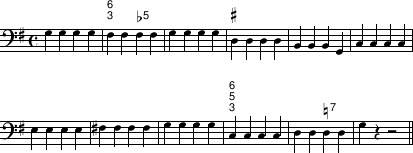






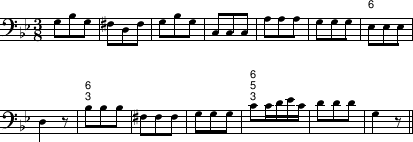










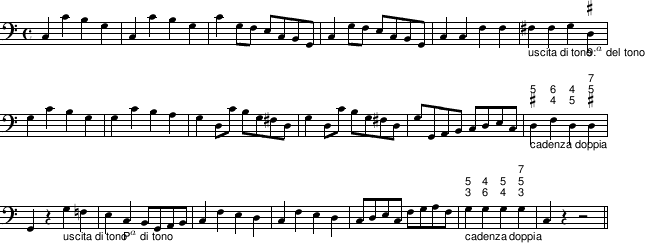
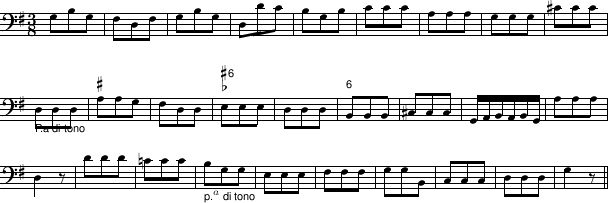

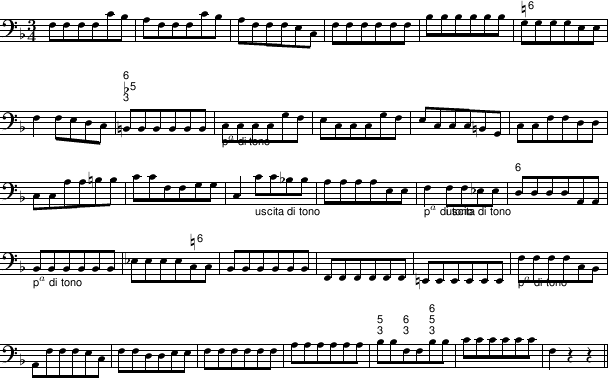




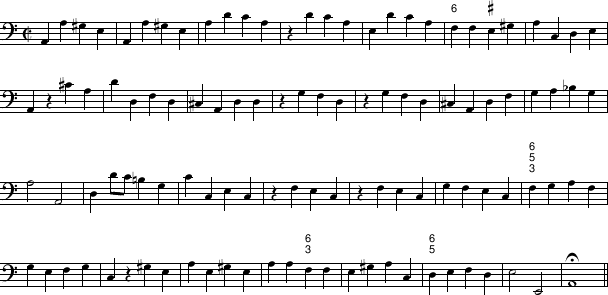
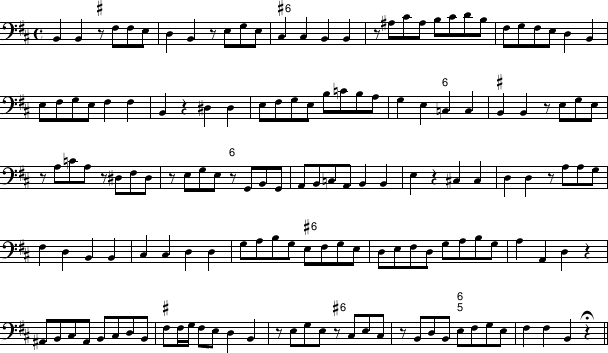

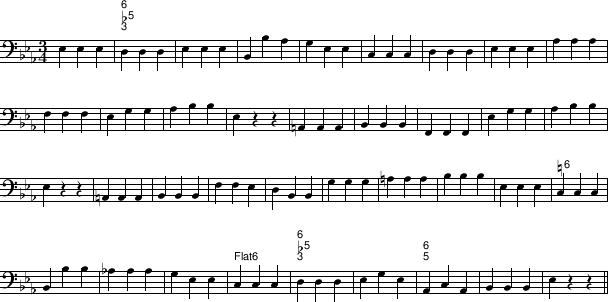
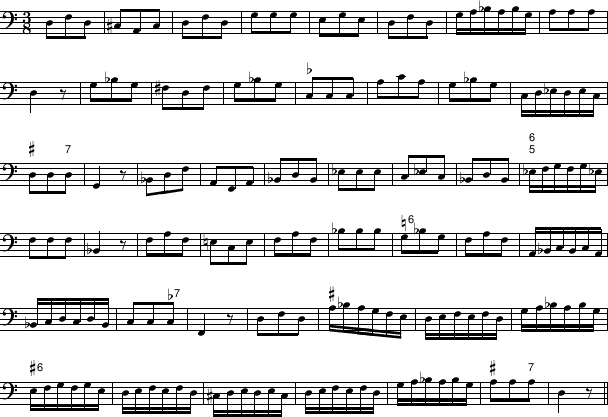




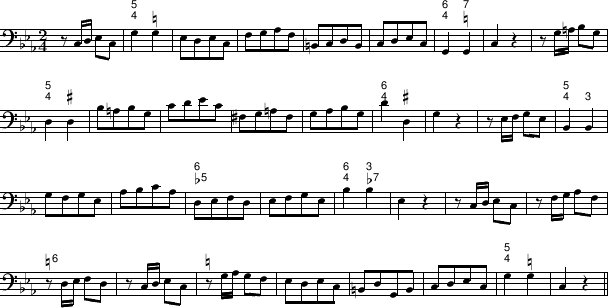


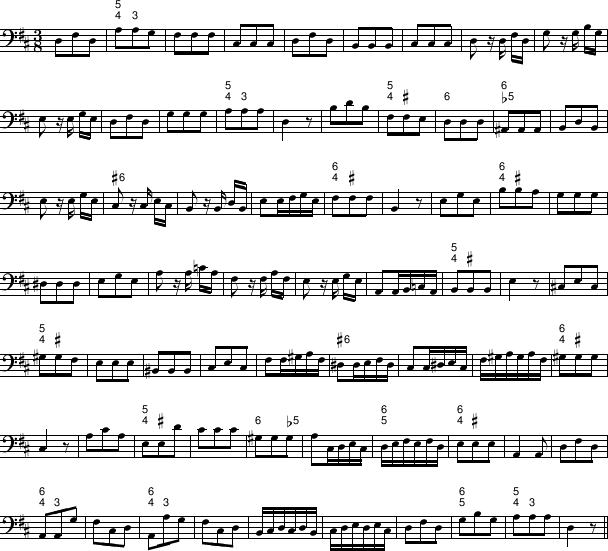


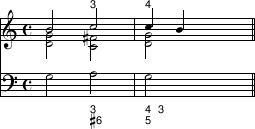

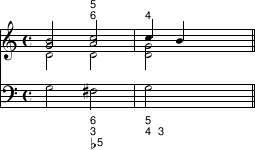
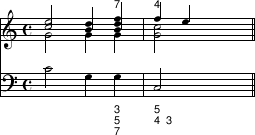

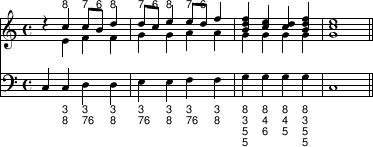
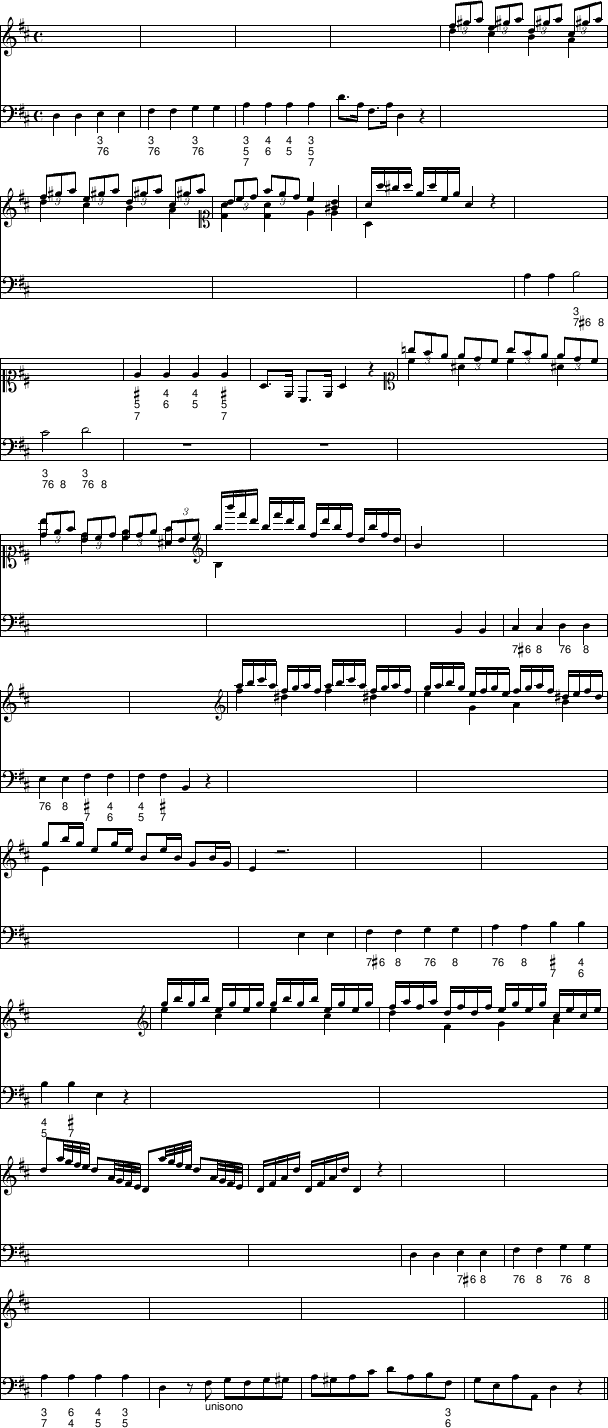
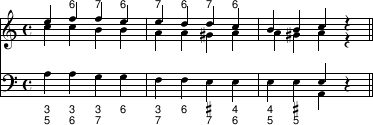
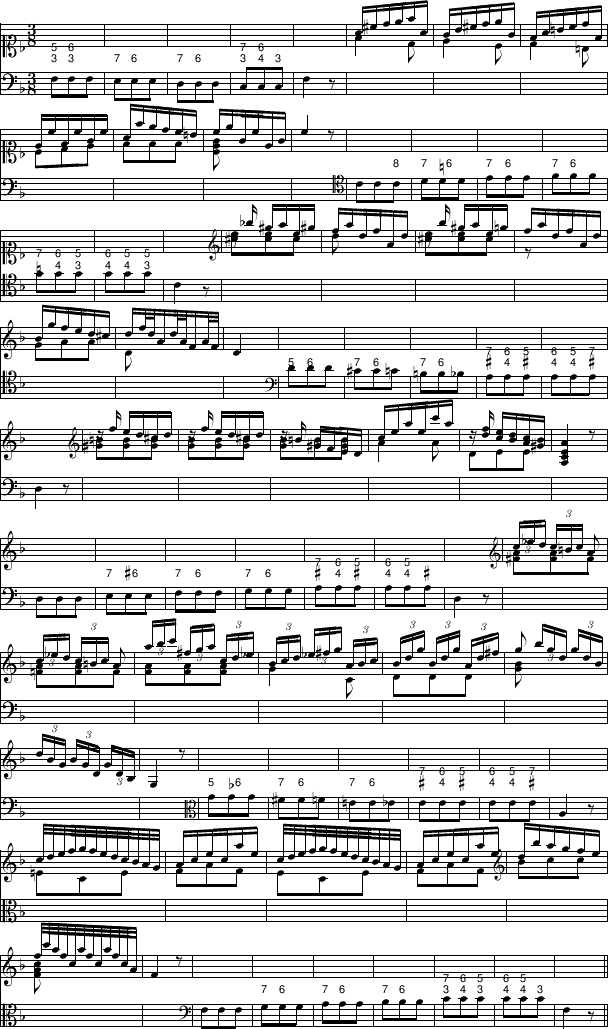
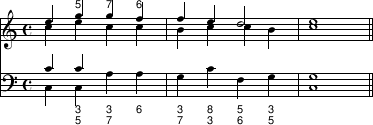
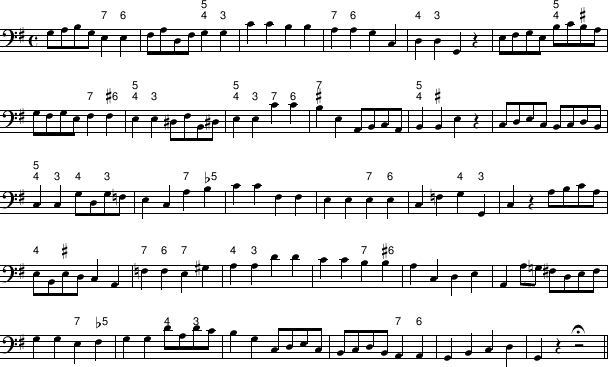
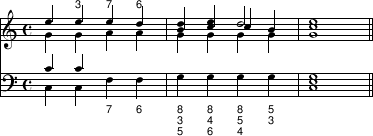


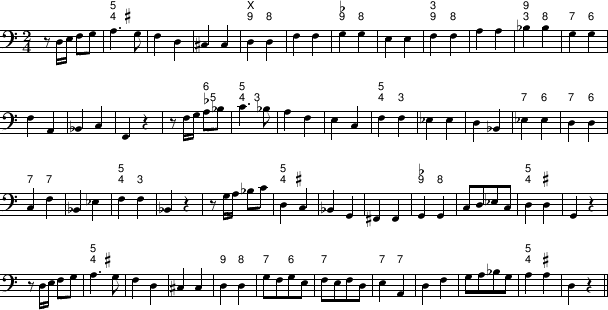




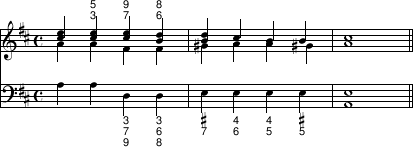


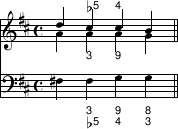

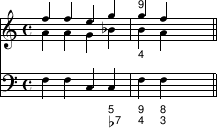
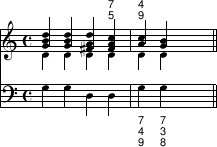

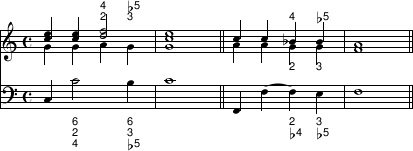

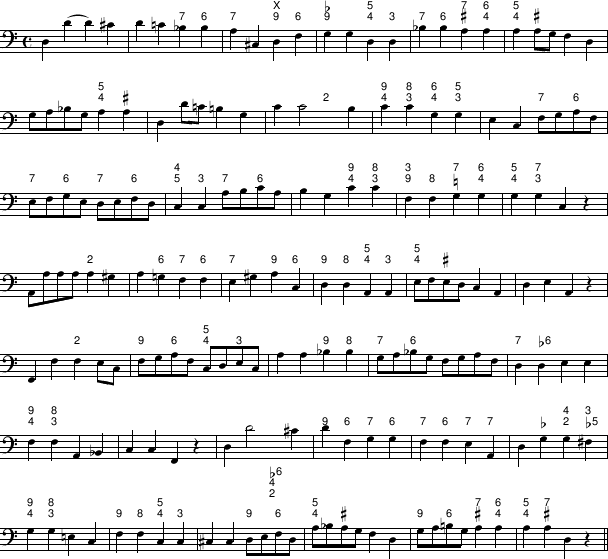
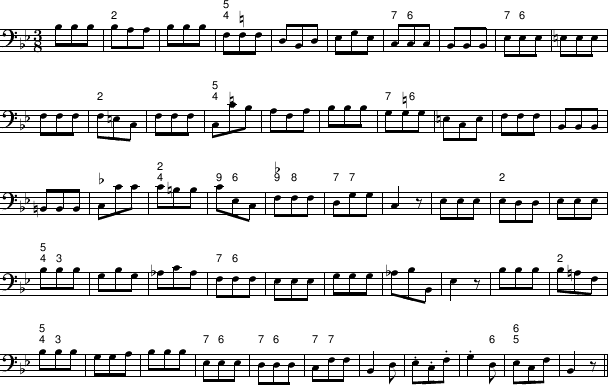



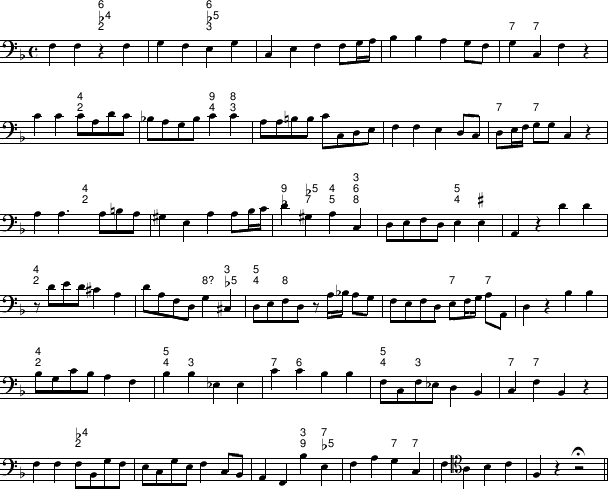


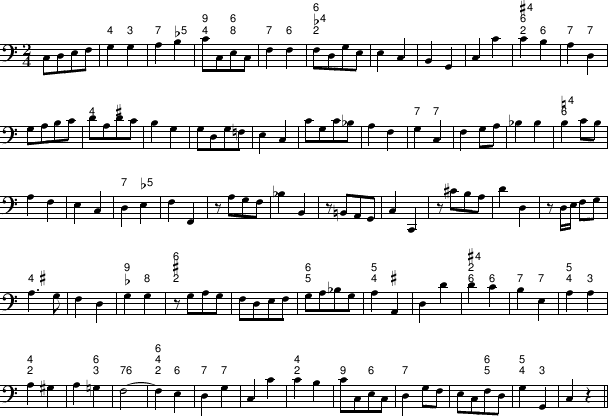

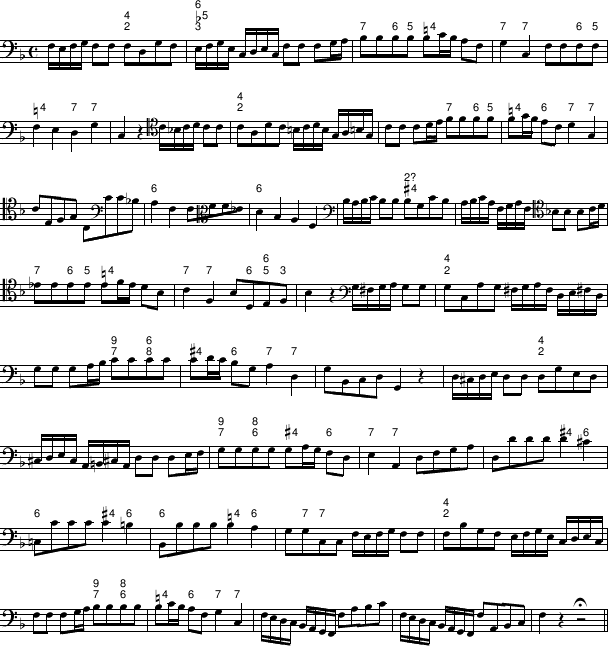
 3.a
3.a o 6.a
o 6.a
 the 3.a
the 3.a or the sixth.
or the sixth.
 , 3.a
, 3.a oder Sexte erhalten.
oder Sexte erhalten.
 , 3.a
, 3.a ou sixte.
ou sixte.
 4.a
4.a e 6.a
qualche volta può ricevere quella nota, che siegue appresso la prima, o
5.a del tono calando di grado.
e 6.a
qualche volta può ricevere quella nota, che siegue appresso la prima, o
5.a del tono calando di grado.
 , 4.a
, 4.a and sixth may
sometimes be given to the note which follown upon the first or the fifth
of the key, descending a step.
and sixth may
sometimes be given to the note which follown upon the first or the fifth
of the key, descending a step.
 , 4.a
, 4.a und Sexte kann
manchmal auch zu der Note gegeben werden, die auf die erste folgt oder die
fünfte des Tons, eine Stufe absteigend.
und Sexte kann
manchmal auch zu der Note gegeben werden, die auf die erste folgt oder die
fünfte des Tons, eine Stufe absteigend.
 , 4.a
, 4.a et sixte peut
parfois recevoir la note qui suit après la première, ou la cinquième du ton,
en descendant conjointement.
et sixte peut
parfois recevoir la note qui suit après la première, ou la cinquième du ton,
en descendant conjointement.


 e 4.a.
e 4.a.
 and thr fourth.
and thr fourth.
 und Quarte.
und Quarte.
 et quarte.
et quarte.
 sicome
occorrenzà.
sicome
occorrenzà.
 , as needed.
, as needed.
 gehe, entsprechend
der Gelegenheit
gehe, entsprechend
der Gelegenheit
 selon
les circonstances.
selon
les circonstances.



